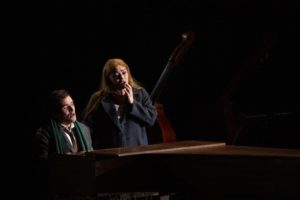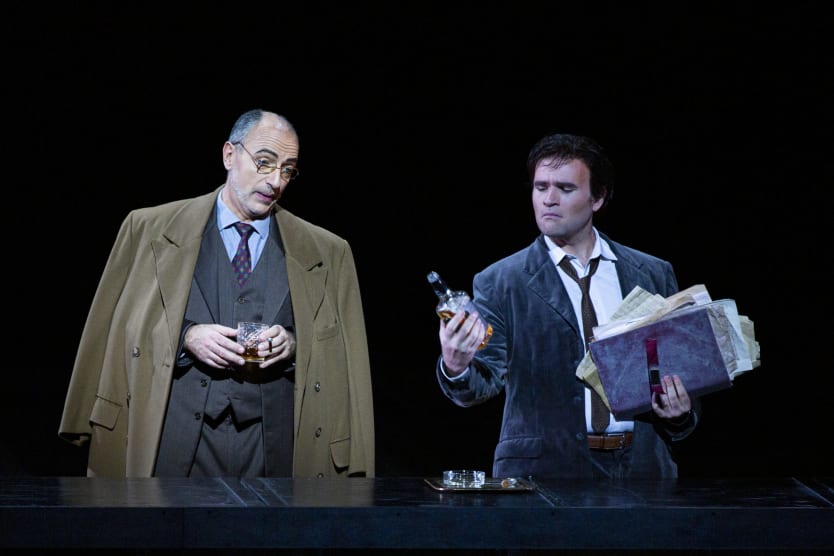
Opéra National de Paris 2019-20 Review: Les Contes d’Hoffmann
Michael Fabiano, Jodie Devos, Ailyn Pérez Lead Wondrous Revival of Carsen’s Ageless Production
By Mauricio Villa(Credit: Guergana Damianova / Opera de Paris)
Attending a French opera in Paris is always a remarkable experience; in this case, as the conductor and most of the cast were French you get a special taste of French style and diction that is difficult to find anywhere else.
On this occasion, the Paris Opera mounted Robert Carsen’s famed production of “Les Contes d’Hoffmann” on the massive Bastille stage.
Carsen’s Theatrical World
In Carsen’s rendition, the famed work is set in an Opera House during a performance of “Don Giovanni,” with each act set in a different part of the theatre. This is arguably Carsen at his purest, taking on a theme of theatre within theatre that has obsessed him throughout his career. There is always a strong reference to “Don Giovanni” in every act. For example the score is always present and plays an important part during the action of the act; we also see a sword, a glass of wine, a spade, and even an eye mask, constantly serving as reminders of the great Mozart-Da Ponte opera. Carsen also manages to clarify the notion presented in the libretto that the four women Hoffmann is in love with are truly one and the same, with the four singers (five if we include the muse) dressed in white and with long blond hair. The sets and costumes designed by Michael Levine are hyper realistic and enormous.
When the curtain rises with the first bars played by the orchestra, we see a complete empty black stage, with Hoffmann drunk stageright, surrounded by empty bottles of wine and papers. A strong, white light comes from the opposite back corner of the stage where the muse enters and walks slowly towards the wasted Hoffmann, who is now seemingly unconscious on the floor. Meanwhile, an entire stage with period sets and costumes representing a scene of “Don Giovanni” with the performers frozen on it, crosses the mainstage from side to side. It remains onstage and throughout the performance, we see crew members actually working backstage of this mini theater.
The stage then transforms quickly into the canteen of the hall, with a huge bar counter rising up from the floor. The chorus enters dressed as staff of the opera house and members of the “Don Giovanni” chorus. After the “Kleinzach” aria, the stage is transformed into the backstage area of “Don Giovanni” as we see the back of the sets, curtain, and props.
The second act takes place in the orchestra pit, while the third act is set in the auditorium of the Opera House, where the rows of seats move sweetly like sea waves. The action returns to the canteen for the beginning of the prologue and the opera finishes as it started, with a bare stage and Hoffmann unconscious on the floor surrounded by bottle and papers. Eventually the hero comes toand walks with the muse towards the light as the curtain falls down.
It is an impressive and meaningful production which showcases all the technical possibilities of the Bastille stage and features some nuanced stagecraft that includes breaking the fourth wall and integraing the audience into the action of the opera.
His Story
American tenor Michael Fabiano debuted the role of Hoffmann on this occasion. It is undeniably a risky choice to make such a debut in front of such a demanding public (in a French opera no less) and some members of the French public didn’t seemed particularly enthusiastic about Fabiano’s performance, showing disapproval during curtain calls. In the opinion of this writer however, he gave a remarkable performance.
Fabiano possesses a big voice which is going towards lirico-spinto, with a natural timbre, good high notes and an unbelievable projection. Hoffmann is a long role with five arias, several duets and ensemble numbers; plus, in this production he is on stage most of the time.
Fabiano really immersed himself in his character as the drunk poet, providing an exhilarating performance of the “Ballade of Kleinzach.” There was some coldness in his voice, as his ascensions to A natural during the faster section of the aria sounded uneasy and forced at times; however, the slow section of the aria, which has an uncomfortable tessitura living on the passaggio of the voice, sounded fluid and effortless. Fabiano did an astonishing diminuendo on the G sharp on “Ah, sa figure ètait charmante” and he was particularly bright-toned on his first act aria “ C’est elle,” which is suits Fabiano’s vocalita quite well. Here he sang a well-supported high B flat on “pour embrasser les cieux;” his high note at the end of the act on “un automate” was similarly impressive. In general, his high notes possess a ringing squillo and strong sound, though the constant use of glissandi and portamenti to reach high notes can seem a bit inelegant at times, especially in the French repertoire.
The Antonia act, which is second in this production, is Hofmann’s most lyrical. Even though he does not have a solo aria, his vocal lines during the duets in this act are full of long melodies with several ascensions to high B naturals where Fabiano seemed very comfortable, his singing featuring fluid legato lines.
But in the Giuletta act the tessitura becomes higher in general, requiring an even mre potent sound. Fabiano sang the aria “Amis, l’amour tendre et rêver, Erreur!” with determination and ease in the passaggio, dispatching the arias many Gs, A flats, and high B flats. But it was in the aria “Ô dieu, di quelle ivresse” where he shined most. Here, Fabiano lightened the sound of his voice and manage to reach high G and A naturals while sustaining the legato of the phrases and attacking the notes directly without his recurrent use of portamenti. He sang “Come des astres radieux” with great intensity, managing the chromatic ascents fearlessly. The interpretation of this arias was the undeniably highlight of his performance.
He did seem to show some signs of fatigue during the final “Kleinzach” during the epilogue, but it was ultimately a splendid debut. There is no doubt that the French repertoire suits Fabiano’s tenor very well.

(Credit: Guergana Damianova / Opera de Paris)
Muse & Villain
French bass-baritone Laurent Naouri portrayed the four villains of the opera, one of his signature roles that he has sung in Paris, Munich, Zurich, Milan, Barcelona, and the Metropolitan Opera.
His lower register has grown in depth and volume, which made his voice ideal for Lindorf or Coppélius, which has a bass writing. But his potency and easiness to attack high notes was particularly noticeable in the role of Dappertutto, which is baritonal in its writing, particularly in his lyrical aria “Scintille diamant;” in this particular section Naouri displayed great control of his high register, emitting two sustained F sharps. His French diction and style are immaculate, and his ability to transform into four completely different personalities was awesome, proving his strong stagecraft.
Young French mezzo-soprano Gaëlle Arquez portrayed the double role of the muse and Nicklausse. Her interpretation was amusing, energetic, and moving. Her voice has a round velvet quality with a sweet vibrato and an equal timbre throughout her whole register.
The role it is genuinely well-written for a mezzo-soprano voice, lying mostly in the middle of the voice, with some descents to low A naturals; however, it never goes much higher than A flat, so it proved no technical difficulty for Arquez, who shined with her vitality in the aria “Une poupée aux yeux d’émail” and for her lyricism in the famous “Barcarolle” of Giuletta’s act.

(Credit: Guergana Damianova / Opera de Paris)
Four Lovers
Leggera soprano Jodie Devos portrayed an impressive and acrobatic Olympia. Carsen’s production was created with Natalie Dessay as Olympia, a soprano was famous for her stratospheric register and the interpolation of extreme high notes as well as amazing abilities as an actress who was able to sing while running, dancing or jumping.
Olympia is all about vocal fireworks; it is a very short part, with only an aria and a short passage of coloratura, but it is very difficult and risky as the sopranos have to go into it without a previous warm up on stage. Devos posses a sweet leggera voice with an excellent technique to confront all the scales, staccato and high notes of the score, and in this interpretation she managed a wide-range of variations, including about six extra high E flats and two high Fs; she also included some new variations of her own which were exquisite. Moreover, she managed all these vocal pyrotechnics while dominating the demanding staging, which includes having sex with Hofmann while doing staccato high B flats. She was funny, energetic, and precise in the mechanical movements required of this staging and managed some high E flats and a trill on a high D with clean coloratura.
American soprano Ailyn Pérez took on the role of Antonia. This is probably the hardest female role in the score. It is the longest one and demands a lyrical voice able to sing long legato phrases, sing pianissimo, and deliver extreme high notes for a lyrical voice, including a sustained high D natural and a C sharp.
Pérez’s voice matched the role perfectly. Even if her voice has grown in volume and has darkened, she has always had an easy high register which made her able to sing Gounod’s Juliette and Massenet’s Manon. The soprano’s interpretation of “Elle a fui, la tourterelle!” was very moving, and she delivered an amazing pianissimo A natural on the second verse. Her voice blended perfectly with Fabiano during their duet and sang several high B naturals effortlessly. She also blasted out long powerfully sustained D natural off stage before following it with a marvelous high C sharp at the end of her scene with Doctor Miracle. Overall, she displayed strong control in the high register, as well as a strong center.
Giuletta was sung by the French soprano Veronique Gens. Unfortunately, she did not have the best of nights, struggling mightily with the high notes in this role. Whenever she had to deliver one of the two B flats during the duet with Hoffmann and later during the septet, she simply couldn’t hold them; during the duet, Fabiano was left alone.
That said, her part is short, and her voice sounded rotund and sensual, especially during the famous “Barcarole.”
Philippe Talbot had the task of impersonating the four characters of Andres, Cochenille, Pitichinaccio and Franzt. These are very short tenor parts, though the part of Frantz has the comical aria “Jour et nuit je mets en quatre,” which Talbot interpreted with a comical imprint that received a notable ovation.
French conductor Pierre Vallet presented a brilliant reading of the score, with a pesante beginning that defined the drama of the plot. He chose bright quick tempi throughout, making the music agile, lively, and amusing, something that suits Offenbach’s score perfectly.
Overall, this was a wonderful, creative, and vast production which has not aged despite of being 20-years-old, with a strong cast and great support from the orchestra, chorus and the conductor. It was a great success for the Opéra National de Paris after its lengthy shutdown.


